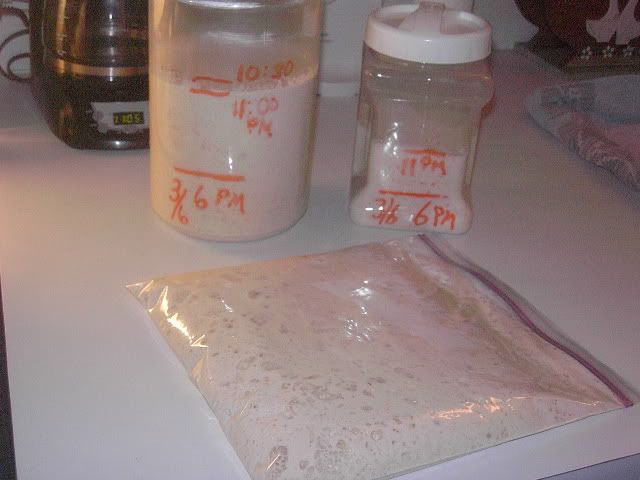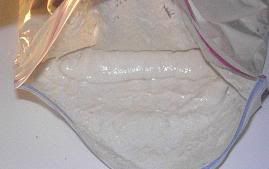
What can I do w/this 'hybrid' thick starter??
I've been reading the forums here for a few months but today is my first post. I'm hoping to get some help/advice on using this (sort of peculiar) "hybrid" starter I've been so carefully nursing (NOT). It was started the 1st week of February.. sort of. It's actually a conglomeration of A/P white & whole wheat flours, spring water and/or pineapple juice. Guess you could just say it consists of the discards of about 30 - 40 feedings of ALL different types of starters (I love to experiment and ended up with a couple kilos of the stuff plus dried & frozen, too - anyone want some?).
When I didn't have the energy (bad health) or was just not in the mood to mess with actually baking, I'd just put multiple portions of discard in a big bowl and add a little water & flour (sometimes more - sometimes less of each). Kept it at a thick batter consistency but it sure itsn't now! Last night when doing the weekly feed I had a fairly empty bag of flour I wanted to get rid of so dumped it in, then added more from another bag but I did not add any water. Maybe 3 to 1 flour/water.. I just don't know. NO idea what the hydration level of this starter is.. but it's been going great-guns for weeks and smells lovely (sour & winey). Through the weeks I've made a million pancakes, 5 doz. cinnamon rolls & 4 loaves of bread with this batch, now I want to try this thicker stuff. Just don't know what to use it in and would like ideas. I'd like to make some bread tomorrow, but will it hurt that this starter is thick but not old-dough thick? Would bread even be a possibility? Help?!?
To give you an idea what it's like...
1. This (in the bag) is what it looked like after a few hours in the oven (my 'proofing box'). I'd filled the bag half full and a few hours later it took off like the dickens - full of holes: (other 2 jars - only a third of what I have - are my fastest starters & some of the stepmothers of the bagged hybrid)

2. Bag after I pushed it all back down so it wouldn't overflow in the oven - this pretty much shows consistency - it took a minute or so for the dough to spread out at all. I mean it will keep a finger-caused dent for 15-20 seconds then slowly start to fill in...

3. This morning the starter had risen right back up - at least double, maybe a touch more, and of course was of a more liquid consistency but not much more!

Now it's been almost 24 hours since I put it together & fed the other two. Off to start over....
But before I go, one more question if you don't mind. While baking/using my starters I'd been feeding twice daily. If I THINK I'm going to bake I'll leave the starters out of the fridge but decided to try once a day feedings. So far they've all risen quite nicely and fell back within about 12 hours (or sooner). For 3 days I've just waited until same time of day that next day and would like to know if this will work the way I'm hoping?? I've yet to see any hooch ('cept for very 1st unsuccessful try) since I started in Feb., either. Is that normal?
Well, I actually have about 6 more questions but I'll let this post stand as it is and wait a bit. But if some nice person would let me know the appropriate place to put a s/dough bread-baking question, I'd really appreciate it!
Thanks!
Marla


You look a little caught up in the miricle making of starter. It is fun isn't it? But if you let it, the discard may chase you out the kitchen!
Your starter sounds just fine and you can bake with it at any time. I haven't seen hooch in years!
About the thick starter, stir it down and use it in a recipe that askes for a build of about 2-3 cups of starter or use as a build of about 400g, adding more flour to it to make a shaggy mass, then let it sit 30 minutes. Then add salt and knead or fold repeatedly to blend in. Let it rise covered and when it does start rising, use the stretch and fold method to add body to the dough and tighten up the gluten. Eventually bake using steam.
You need to cut down the size of your starter to prevent so much waste. It can easily be increased when you need it. Do it by only feeding a tablespoon or two of starter when you cannot bake regularly.
Where to put Questions? You could try using the search box, reading some threads on the topic you wish to know about, then ask the question there or you can return to this thread. Just type what comes to mind. Sounds like your starter is doing very well and that you can churn out bread at any time. Looking forward to seeing that first loaf. Welcome to TFL!
Mini, SKorea
I just posted on my blog today about sourdough bread: http://veggieinmilwaukee.wordpress.com/
I like to keep my starter at a 1x1 ratio: equal parts water to flour by weight. This makes it easy to figure out hyrdration when you want to use it in a recipe. Also, a 1x1 ratio makes it easier for your yeast to propagate. Your starter can really be any consistency that you want. Some people like working with a stiff starter and some like a soup consistency. It really doesn't matter as long as you account for the amount of water in your starter when you want to use it in a recipe. An easy way to get an idea of what your hydration is is to pick a hydration and stick with a constant feeding schedule where you are using that hydration. After a few feeds you will be close to the hydration that you want.
Check out my blog for a formula using a sourdough starter. I have made dozens of baguettes with this formula and they have all produced superior breads.